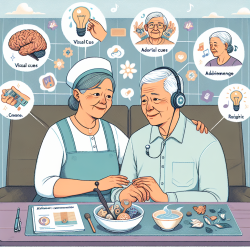Enhancing Communication with Alzheimer's Patients Using Auditory and Visual Cues
Communication challenges are a hallmark of Dementia of Alzheimer's Type (DAT), significantly impacting the quality of life for patients and their caregivers. A recent study, "Auditory and Visual Cues for Topic Maintenance with Persons Who Exhibit Dementia of Alzheimer's Type," provides valuable insights into how caregivers can improve conversational coherence through strategic cueing.
Understanding the Study
The study explored the effectiveness of auditory and visual cues in maintaining topic coherence during conversations with DAT patients. Five individuals with moderate-stage DAT participated, engaging in discussions about daily living activities, recreational activities, food, and grooming. The study found that both auditory and visual redirections significantly improved topic maintenance compared to baseline conditions.
Key Findings
- Visual cues were particularly effective in discussions about food, suggesting that visual stimuli can evoke more robust discourse.
- Auditory cues were most effective in conversations about recreational activities, indicating that verbal prompts can enhance engagement.
- Overall, both cue types improved topic coherence, doubling the coherence scores compared to baseline conditions.
Implementing the Findings
As a practitioner, you can leverage these findings to enhance your communication strategies with Alzheimer's patients. Here are some practical tips:
- Use Visual Aids: Incorporate picture cards or visual prompts when discussing daily activities, especially food-related topics. This can help anchor the conversation and improve coherence.
- Verbal Redirection: Employ auditory cues like restating the topic or paraphrasing relevant ideas to guide the conversation back on track.
- Personalize Cues: Tailor visual and auditory cues to the individual preferences and interests of each patient to maximize engagement and relevance.
Encouraging Further Research
While this study provides a strong foundation, further research is needed to explore the long-term benefits of these cueing strategies and their effectiveness across different stages of DAT. Practitioners are encouraged to contribute to this growing field by experimenting with these techniques and sharing their findings.
To read the original research paper, please follow this link: Auditory and Visual Cues for Topic Maintenance with Persons Who Exhibit Dementia of Alzheimer's Type.










